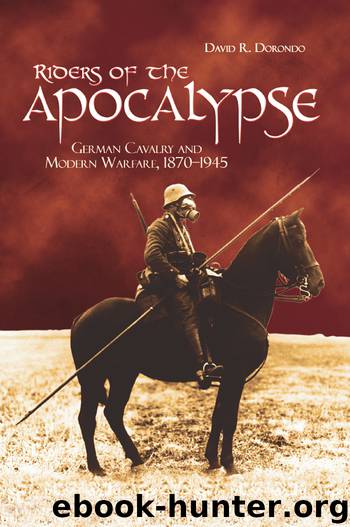Riders of the Apocalypse by David R. Dorondo

Author:David R. Dorondo
Language: eng
Format: epub
Publisher: Naval Institute Press
Map 5. Eastern Front, General Situation, Late September 1941
Despite constant references in this period to the threat posed by partisans and the emphatic order that the men should always carry loaded weapons except when in their quarters, divisional command also kept insisting that soldierly discipline be maintained. Unauthorized shooting, apparently widespread, was expressly forbidden because it wasted ammunition and revealed defensive positions. Furthermore, graffiti and stuffed animals were not to be used to decorate the division's vehicles, the stuffed animals evidently being attached to radiator-caps as hood ornaments. Furthermore, men were strictly ordered not to appear out of uniform. Decorations were to be worn and military courtesies always observed. Such observances remained the “calling card of any unit.” In sum, as General Feldt wrote, the Cavalry Division was to be known as a unit in which “exemplary discipline reigned.”45 Perhaps he felt that the strain of the campaign could only be rectified by discipline and good order. Perhaps, too, he felt that he had other good grounds for urging such exemplary discipline. As it turns out, in September 1941 the division was in the process of beginning a reorganization, with all of the administrative and personal tumult that a reorganization in wartime brings with it. Fate and the OKW/OKH had decreed that the 1st Cavalry Division was to give up its horses and replace them with tanks. It was to become a panzer division.
In 1939 the ultimate fate of the then-1st Cavalry Brigade had still been uncertain. Even earlier, the German cavalry's corps and divisional structures had been ordered abolished, effective 1936; and, as has been seen, the army's cavalry regiments had been tasked at that time to provide squadrons for the infantry divisions' organic reconnaissance battalions, as well as cavalry troops (i.e., companies) for individual infantry regiments. Only the 1st Cavalry Brigade had remained as an autonomous, dedicated, horse-mounted unit. Following its expansion in the winter of 1940–1941, the Cavalry Division had been ordered, in addition to its actual operational objectives, to determine whether horse-cavalry in the eastern campaign could still execute useful missions or whether its role could be better served by armored formations. Now, in the autumn of 1941, General Feldt submitted his answer to that question.46
He began by noting that throughout the eastern campaign, the division had been assigned the following missions: screening the flanks of German armies and panzer groups; closing the gaps between friendly units; pursuing Soviet forces along the flanks and in front of German infantry corps; rapidly seizing and holding sections of the front until follow-on forces came up; attacking the flanks and rear of enemy formations; and executing wholly dismounted defensive infantry operations. With the exception of the last-named task, all of these were traditional functions of the cavalry. In Feldt's view, all of these missions had been completely accomplished. By itself, as he also noted, the Cavalry Division could not contribute decisive combat power, and other German formations had done quite as well with no attached cavalry at all. Nonetheless,
Download
This site does not store any files on its server. We only index and link to content provided by other sites. Please contact the content providers to delete copyright contents if any and email us, we'll remove relevant links or contents immediately.
| Africa | Americas |
| Arctic & Antarctica | Asia |
| Australia & Oceania | Europe |
| Middle East | Russia |
| United States | World |
| Ancient Civilizations | Military |
| Historical Study & Educational Resources |
The Radium Girls by Kate Moore(11865)
100 Deadly Skills by Clint Emerson(4798)
Rise and Kill First by Ronen Bergman(4658)
The Templars by Dan Jones(4593)
The Doomsday Machine by Daniel Ellsberg(4375)
The Rape of Nanking by Iris Chang(4103)
Killing England by Bill O'Reilly(3927)
Hitler in Los Angeles by Steven J. Ross(3865)
Stalin by Stephen Kotkin(3826)
12 Strong by Doug Stanton(3456)
Hitler's Monsters by Eric Kurlander(3243)
Blood and Sand by Alex Von Tunzelmann(3101)
Darkest Hour by Anthony McCarten(3040)
The Code Book by Simon Singh(3022)
The Art of War Visualized by Jessica Hagy(2892)
Hitler's Flying Saucers: A Guide to German Flying Discs of the Second World War by Stevens Henry(2664)
Babylon's Ark by Lawrence Anthony(2488)
The Second World Wars by Victor Davis Hanson(2452)
Tobruk by Peter Fitzsimons(2416)
